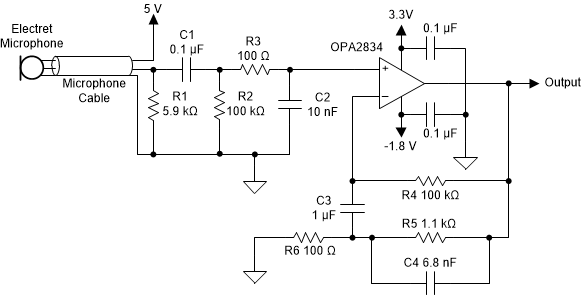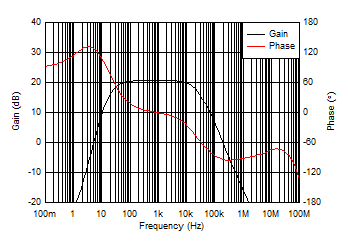SBOS973A June 2019 – September 2019 OPA2834
PRODUCTION DATA.
- 1 Features
- 2 Applications
- 3 Description
- 4 Revision History
- 5 Device Comparison Table
- 6 Pin Configuration and Functions
- 7 Specifications
- 8 Detailed Description
- 9 Application and Implementation
- 10Power Supply Recommendations
- 11Layout
- 12Device and Documentation Support
- 13Mechanical, Packaging, and Orderable Information
Package Options
Mechanical Data (Package|Pins)
- DGK|8
Thermal pad, mechanical data (Package|Pins)
- DGK|8
Orderable Information
9.2.4 Microphone Pre-Amplifier
 Figure 60. Low-Power Microphone Pre-Amplifier
Figure 60. Low-Power Microphone Pre-Amplifier Figure 60 shows an example circuit of the audio pre-amplifier application using OPA2834. The excellent distortion performance and the ultra-low quiescent current, make OPA2834 a very attractive solution for the portable and handheld audio instruments. Figure 60 circuit is a bandpass filter with frequency cutoff at 5 Hz and 180 kHz. The OPA2834 is connected to a positive 3.3 V and a negative 1.8 V supply. the primary reason for the skew in the power supply is to enable the maximum dynamic range possible to the user. The VICR of OPA2834 mentioned in Electrical Characteristics: 3V to 5V is 1.1 V from the positive rail. Thus having a skewed power supply like in Figure 60 gives a common-mode input range from -2 V up to 2.2 V.
 Figure 61. Frequency Response of Microphone Pre-Amplifier
Figure 61. Frequency Response of Microphone Pre-Amplifier